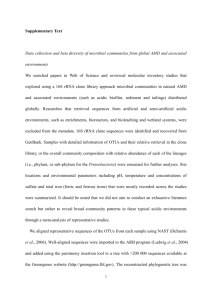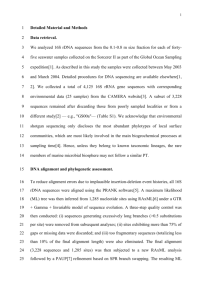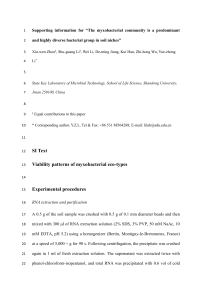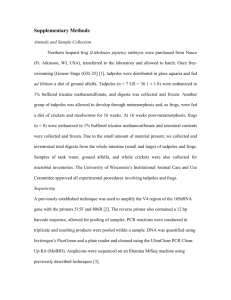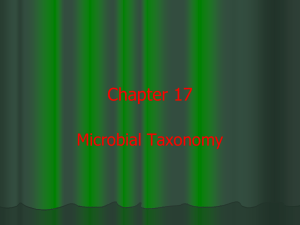SOM Fig - Nature
advertisement
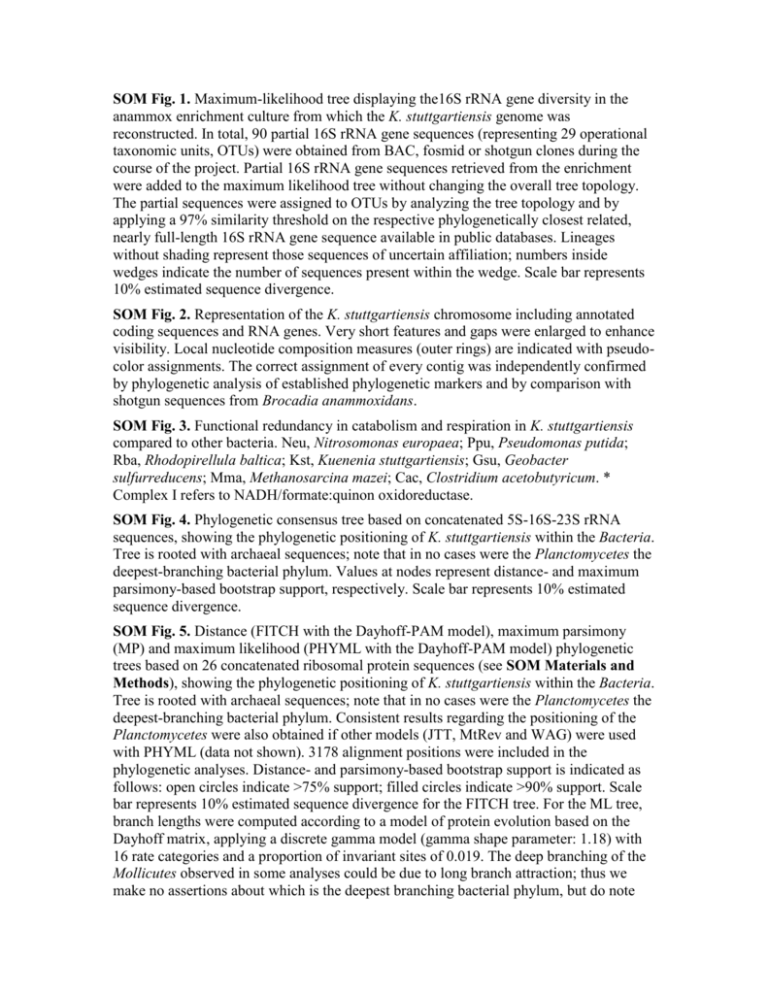
SOM Fig. 1. Maximum-likelihood tree displaying the16S rRNA gene diversity in the anammox enrichment culture from which the K. stuttgartiensis genome was reconstructed. In total, 90 partial 16S rRNA gene sequences (representing 29 operational taxonomic units, OTUs) were obtained from BAC, fosmid or shotgun clones during the course of the project. Partial 16S rRNA gene sequences retrieved from the enrichment were added to the maximum likelihood tree without changing the overall tree topology. The partial sequences were assigned to OTUs by analyzing the tree topology and by applying a 97% similarity threshold on the respective phylogenetically closest related, nearly full-length 16S rRNA gene sequence available in public databases. Lineages without shading represent those sequences of uncertain affiliation; numbers inside wedges indicate the number of sequences present within the wedge. Scale bar represents 10% estimated sequence divergence. SOM Fig. 2. Representation of the K. stuttgartiensis chromosome including annotated coding sequences and RNA genes. Very short features and gaps were enlarged to enhance visibility. Local nucleotide composition measures (outer rings) are indicated with pseudocolor assignments. The correct assignment of every contig was independently confirmed by phylogenetic analysis of established phylogenetic markers and by comparison with shotgun sequences from Brocadia anammoxidans. SOM Fig. 3. Functional redundancy in catabolism and respiration in K. stuttgartiensis compared to other bacteria. Neu, Nitrosomonas europaea; Ppu, Pseudomonas putida; Rba, Rhodopirellula baltica; Kst, Kuenenia stuttgartiensis; Gsu, Geobacter sulfurreducens; Mma, Methanosarcina mazei; Cac, Clostridium acetobutyricum. * Complex I refers to NADH/formate:quinon oxidoreductase. SOM Fig. 4. Phylogenetic consensus tree based on concatenated 5S-16S-23S rRNA sequences, showing the phylogenetic positioning of K. stuttgartiensis within the Bacteria. Tree is rooted with archaeal sequences; note that in no cases were the Planctomycetes the deepest-branching bacterial phylum. Values at nodes represent distance- and maximum parsimony-based bootstrap support, respectively. Scale bar represents 10% estimated sequence divergence. SOM Fig. 5. Distance (FITCH with the Dayhoff-PAM model), maximum parsimony (MP) and maximum likelihood (PHYML with the Dayhoff-PAM model) phylogenetic trees based on 26 concatenated ribosomal protein sequences (see SOM Materials and Methods), showing the phylogenetic positioning of K. stuttgartiensis within the Bacteria. Tree is rooted with archaeal sequences; note that in no cases were the Planctomycetes the deepest-branching bacterial phylum. Consistent results regarding the positioning of the Planctomycetes were also obtained if other models (JTT, MtRev and WAG) were used with PHYML (data not shown). 3178 alignment positions were included in the phylogenetic analyses. Distance- and parsimony-based bootstrap support is indicated as follows: open circles indicate >75% support; filled circles indicate >90% support. Scale bar represents 10% estimated sequence divergence for the FITCH tree. For the ML tree, branch lengths were computed according to a model of protein evolution based on the Dayhoff matrix, applying a discrete gamma model (gamma shape parameter: 1.18) with 16 rate categories and a proportion of invariant sites of 0.019. The deep branching of the Mollicutes observed in some analyses could be due to long branch attraction; thus we make no assertions about which is the deepest branching bacterial phylum, but do note that there is no indications at this stage of Planctomycetes filling this role. Future sequencing of genomes from other closely related organisms (such as Verrucomicrobium spinosum currently being sequenced at TIGR) should help to elucidate the precise phylogenetic positioning of the Planctomycetes.


